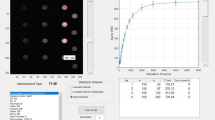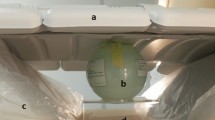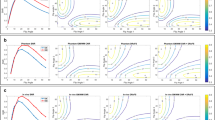Abstract
It is well known that the quality of a quantitative31P MRS measurement relies largely on the performance of the volume selection method, and that image selected in vivo spectroscopy (ISIS) suffers from contaminating signal caused mostly by Tl smearing. However, these signal errors and their magnitude are seldom addressed in clinical studies. The aim of this study was therefore to investigate the magnitude of signal errors in31P MRS when using ISIS. The results from the measurements with a homogeneous head phantom are as follows: at low TR/T1 ratios the contamination increases rapidly, especially for small (< 27 cm3) VOI sizes; at TR/T1 = 1, the signal from a 27 cm3 VOI was 20% too high, and from an 8 cm3 VOI 150% too high. The signal obtained from different VOI positions varied between 80 and 127%. The signal varied linearly with the31P concentration in the object. However, a too high signal was obtained when the concentration was lower in the region of interest (inner container) than in the rest of the phantom. The agreement between the simulations and measurements shows that the results of this study are generally applicable to the measurement geometry and the ISIS experiment order rather than being specific for the MR system studied. The errors obtained both experimentally and in computer simulations are too large to be ignored in clinical studies using the ISIS pulse sequence.
Similar content being viewed by others
References
Bovée WMMJ, de Beer R, van Ormondt D, Luvten PR, den Hollander JA. Quantitation in whole body MRS. Encyclopedia of nuclear magnetic resonance. Chichester: Wiley, 1996.
Tofts PS, Wray SA. Critical assessment of methods of measuring metabolite concentrations by NMR spectroscopy. NMR Biomed 1988; 1(1):1–10.
Ordidge RJ, Connelly A, Lohman JAB. Image-selected in vivo spectroscopy (ISIS). A new technique for spatially selective NMR spectroscopy. J Magn Reson 1986;66:283–94.
Lawry TJ, Karczmar GS, Weiner MW, Maison GB. Computer simulation of MRS localization techniques: an analysis of ISIS. Magn Reson Med 1989;9:299–314.
Burger C, Buchli R, McKinnon G, Meier D, Boesiger P. The impact of the ISIS experiment order on spatial contamination. Magn Reson Med 1992;26:218–30.
Ljungberg M, Starck G. Vikhoff-Baaz B, Alpsten M. Ekholm S. Forssell-Aronsson E. Extended ISIS sequence insensitive to Tl smearing. Magn Reson Med 2000;44:546–55.
Luvten PR, Groen JP, Vermeulen AHJW, den Hollander JA. Experimental approaches to image localized human31P NMR spectroscopy. Magn Reson Med 1989; 11:1–21.
Silver MS, Joseph RI, Chen CN, Sank VJ, Hoult DI. Selective population inversion in NMR. Nature 1984;310:681–3.
Bendall MR, Pegg DT. Uniform sample excitation with surface coils for in vivo spectroscopy by adiabatic rapid half passage. J Magn Reson 1986;67:376–81.
Starck G, Lundin R, Forssell-Aronsson E, Arvidsson M, Alpsten M, Ekholm S. Evaluation of volume selection methods in in vivo MRS. Design of a new test phantom. Acta Radiol 1995;36:317–22.
Ljungberg M. Thesis, Department of Radiation Physics, Göteborg University, Göteborg, Sweden; 1999 (ISBN 91-628-3531-9).
Leach MO, Collins DJ, Keevil S, Rowland I, Smith MA, Henriksen O, Bovée WMMJ, Podo F. Quality assessment in in vivo NMR spectroscopy: IH. Clinical test objects: design, construction, and solutions. Magn Reson Imag 1995;13:131–7.
Ljungberg M, Starck G, Forssell-Aronsson E, Alpsten M, Ekholm S. Signal profile measurements for evaluation of the volume-selection performance of ISIS. NMR Biomed 1995;8:271–7.
Buchli R, Due CO, Martin E, Boesiger P. Assessment of absolute metabolite concentrations in human tissue by 31P MRS in vivo. Part I: cerebrum, cerebellum, cerebral grey and white matter, Magn Reson Med 1994:32:447–52.
Bottomley PA, Cousins JP, Pendrey DL, Wagle WA, Hardy CJ, Eames FA, McCaffrey RJ, Thomson DA. Alzheimer dementia: quantification of energy metabolism and mobile phosphoesters with P-31 NMR spectroscopy. Radiology 1992;183(3):695–9.
Roth K, Hubesch B, Meyerhoff DJ, Naruse S, Gober JR, Lawry TJ, Boska MD, Matson GB, Weiner MW. Noninvasive quantitation of phosphorus metabolites in human tissue by NMR spectroscopy. J Magn Reson 1989;81:299–311.
Ljungberg M, Starck G, Vikhoff-Baaz B, Forssell-Aronsson E, Alpsten M, Ekholm S. Signal profile measurements of single- and double-volume acquisitions with image-selected in vivo spectroscopy for51P magnetic resonance spectroscopy. Magn Reson Imag 1998;16:829–37.
Author information
Authors and Affiliations
Corresponding author
Rights and permissions
About this article
Cite this article
Ljungberg, M., Starck, G., Vikhoff-Baaz, B. et al. The magnitude of signal errors introduced by ISIS in quantitative31P MRS. MAGMA 14, 30–38 (2002). https://doi.org/10.1007/BF02668184
Received:
Revised:
Accepted:
Issue Date:
DOI: https://doi.org/10.1007/BF02668184




